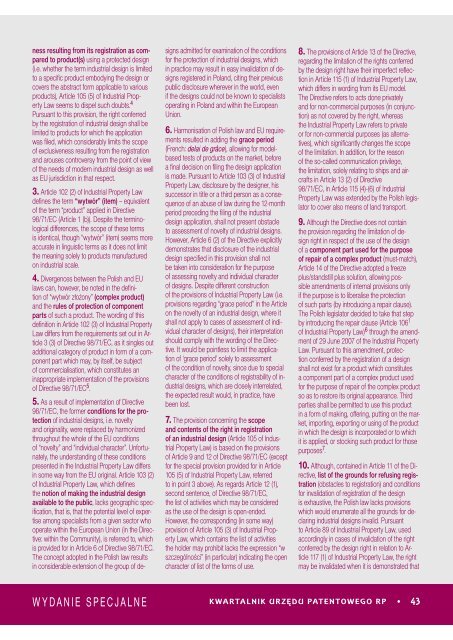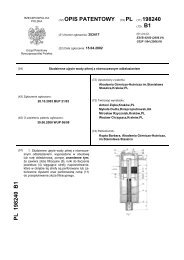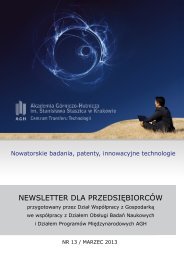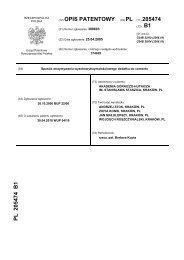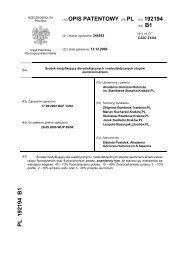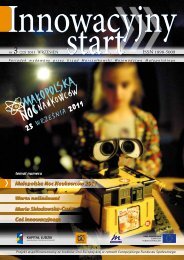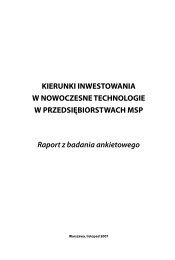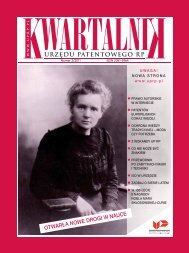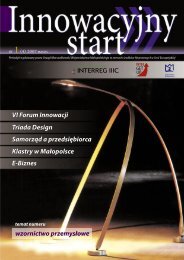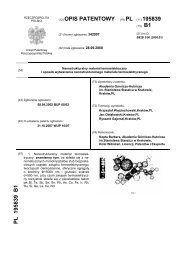Wyd. specjalne/2011 - Regionalny OÅrodek Informacji Patentowej ...
Wyd. specjalne/2011 - Regionalny OÅrodek Informacji Patentowej ...
Wyd. specjalne/2011 - Regionalny OÅrodek Informacji Patentowej ...
- No tags were found...
Create successful ePaper yourself
Turn your PDF publications into a flip-book with our unique Google optimized e-Paper software.
ness resulting from its registration as comparedto product(s) using a protected design(i.e. whether the term industrial design is limitedto a specific product embodying the design orcovers the abstract form applicable to variousproducts), Article 105 (5) of Industrial PropertyLaw seems to dispel such doubts. 4Pursuant to this provision, the right conferredby the registration of industrial design shall belimited to products for which the applicationwas filed, which considerably limits the scopeof exclusiveness resulting from the registrationand arouses controversy from the point of viewof the needs of modern industrial design as wellas EU jurisdiction in that respect.3. Article 102 (2) of Industrial Property Lawdefines the term “wytwór” (item) – equivalentof the term “product” applied in Directive98/71/EC (Article 1 (b)). Despite the terminologicaldifferences, the scope of these termsis identical, though “wytwór” (item) seems moreaccurate in linguistic terms as it does not limitthe meaning solely to products manufacturedon industrial scale.4. Divergences between the Polish and EUlaws can, however, be noted in the definitionof “wytwór złożony” (complex product)and the rules of protection of componentparts of such a product. The wording of thisdefinition in Article 102 (3) of Industrial PropertyLaw differs from the requirements set out in Article3 (3) of Directive 98/71/EC, as it singles outadditional category of product in form of a componentpart which may, by itself, be subjectof commercialisation, which constitutes aninappropriate implementation of the provisionsof Directive 98/71/EC 5 .5. As a result of implementation of Directive98/71/EC, the former conditions for the protectionof industrial designs, i.e. noveltyand originality, were replaced by harmonizedthroughout the whole of the EU conditionsof “novelty” and “individual character”. Unfortunately,the understanding of these conditionspresented in the Industrial Property Law differsin some way from the EU original. Article 103 (2)of Industrial Property Law, which definesthe notion of making the industrial designavailable to the public, lacks geographic specification,that is, that the potential level of expertiseamong specialists from a given sector whooperate within the European Union (in the Directive:within the Community), is referred to, whichis provided for in Article 6 of Directive 98/71/EC.The concept adopted in the Polish law resultsin considerable extension of the group of designsadmitted for examination of the conditionsfor the protection of industrial designs, whichin practice may result in easy invalidation of designsregistered in Poland, citing their previouspublic disclosure wherever in the world, evenif the designs could not be known to specialistsoperating in Poland and within the EuropeanUnion.6. Harmonisation of Polish law and EU requirementsresulted in adding the grace period(French: delai de grâce), allowing for modelbasedtests of products on the market, beforea final decision on filing the design applicationis made. Pursuant to Article 103 (3) of IndustrialProperty Law, disclosure by the designer, hissuccessor in title or a third person as a consequenceof an abuse of law during the 12-monthperiod preceding the filing of the industrialdesign application, shall not present obstacleto assessment of novelty of industrial designs.However, Article 6 (2) of the Directive explicitlydemonstrates that disclosure of the industrialdesign specified in this provision shall notbe taken into consideration for the purposeof assessing novelty and individual characterof designs. Despite different constructionof the provisions of Industrial Property Law (i.e.provisions regarding “grace period” in the Articleon the novelty of an industrial design, where itshall not apply to cases of assessment of individualcharacter of designs), their interpretationshould comply with the wording of the Directive.It would be pointless to limit the applicationof ‘grace period’ solely to assessmentof the condition of novelty, since due to specialcharacter of the conditions of registrability of industrialdesigns, which are closely interrelated,the expected result would, in practice, havebeen lost.7. The provision concerning the scopeand contents of the right in registrationof an industrial design (Article 105 of IndustrialProperty Law) is based on the provisionsof Article 9 and 12 of Directive 98/71/EC (exceptfor the special provision provided for in Article105 (5) of Industrial Property Law, referredto in point 3 above). As regards Article 12 (1),second sentence, of Directive 98/71/EC,the list of activities which may be consideredas the use of the design is open-ended.However, the corresponding (in some way)provision of Article 105 (3) of Industrial PropertyLaw, which contains the list of activitiesthe holder may prohibit lacks the expression “wszczególności” (in particular) indicating the opencharacter of list of the forms of use.8. The provisions of Article 13 of the Directive,regarding the limitation of the rights conferredby the design right have their imperfect reflectionin Article 115 (1) of Industrial Property Law,which differs in wording from its EU model.The Directive refers to acts done privatelyand for non-commercial purposes (in conjunction)as not covered by the right, whereasthe Industrial Property Law refers to privateor for non-commercial purposes (as alternatives),which significantly changes the scopeof the limitation. In addition, for the reasonof the so-called communication privilege,the limitation, solely relating to ships and aircraftsin Article 13 (2) of Directive98/71/EC, in Article 115 (4)-(6) of IndustrialProperty Law was extended by the Polish legislatorto cover also means of land transport.9. Although the Directive does not containthe provision regarding the limitation of designright in respect of the use of the designof a component part used for the purposeof repair of a complex product (must-match),Article 14 of the Directive adopted a freezeplus/standstill plus solution, allowing possibleamendments of internal provisions onlyif the purpose is to liberalise the protectionof such parts (by introducing a repair clause).The Polish legislator decided to take that stepby introducing the repair clause (Article 106 1of Industrial Property Law) 6 through the amendmentof 29 June 2007 of the Industrial PropertyLaw. Pursuant to this amendment, protectionconferred by the registration of a designshall not exist for a product which constitutesa component part of a complex product usedfor the purpose of repair of the complex productso as to restore its original appearance. Thirdparties shall be permitted to use this productin a form of making, offering, putting on the market,importing, exporting or using of the productin which the design is incorporated or to whichit is applied, or stocking such product for thosepurposes 7 .10. Although, contained in Article 11 of the Directive,list of the grounds for refusing registration(obstacles to registration) and conditionsfor invalidation of registration of the designis exhaustive, the Polish law lacks provisionswhich would enumerate all the grounds for declaringindustrial designs invalid. Pursuantto Article 89 of Industrial Property Law, usedaccordingly in cases of invalidation of the rightconferred by the design right in relation to Article117 (1) of Industrial Property Law, the rightmay be invalidated when it is demonstrated that<strong>Wyd</strong>anie <strong>specjalne</strong> KWARTALNIK URZĘDU PATENTOWEGO RP • 43


